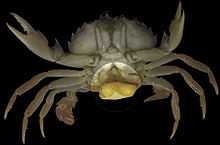Parasitic castration

The parasitic castration strategy is used by some larval trematode parasites of snails and some isopod and barnacle parasites of crustaceans.[4] For example, 18 species of trematodes are known to parasitically castrate the California horn snail, Cerithidea californica.[5]
Evolutionary considerations
A parasite that ends the reproductive life of its host theoretically liberates a significant fraction of the host's resources, which can now be used to benefit the parasite. Lafferty points out that the fraction of intact host energy spent on reproduction includes not just gonads and gametes but also secondary sexual characteristics, mate-seeking behavior, competition, and care for offspring.[4] Poulin suggests that prolonged host life may also result from parasitic castration, benefiting the parasite.[3]
The evolutionary pressure of parasitic castrators on a potential host population is in the direction of resistance to being infected rather than on post-infection recovery. Once fertility has been lost or reduced, the host gains much less evolutionary advantage by surviving the parasite than it would have by avoiding it.[4]
Once the host's reproductive ability is lost, any future changes in host behavior cannot directly benefit the host's reproductive fitness but may benefit the parasite's. Several cases have been described where infection with a parasitic castrator causes the host to change its behavior in ways that benefit the parasite.[3]
Parasitic castrators and parasitoids
The parasitoid strategy, which results in the death of the host, has many similarities to the parasitic castration strategy, which results in the reproductive death of the host. For example, both parasitoids and parasitic castrators tend to be similar to their host in size, whereas most non-castrating parasites are many orders of magnitude smaller than the host. In both strategies, an infected host is much less hospitable to new parasites than an uninfected one.[6]
Examples of parasitic castrators
| Parasite | Host | Remarks |
|---|---|---|
| Protist Sporozoa Mackinnonia tubificis | Annelid Oligochaete Tubifex tubifex | Destroys gonad[6] |
| Protist Haplosporidia Urosporidium charletti | Cestoda Catenotaenia dendritica | "Hypercastrator" (a hyperparasite that castrates the parasite it parasitizes)[6] |
| Platyhelminthes Trematoda Bucephalus mytili | Mollusca Bivalvia | Destroys gonad, host grows larger[6] |
| Platyhelminthes Cestoda | Pisces Cyprinidae | Destroys gonad, behavioral changes[6] |
| Arthropoda Isopoda Hemioniscus balani | Arthropoda Cirripedia barnacles | Drains ovarian fluid of hermaphrodite, but spares male function[2] |
| Arthropoda Cirripedia Sacculina | Arthropoda Decapoda crabs | Destroys gonad, behavioral changes[6] |
| Arthropoda Strepsiptera | Arthropoda Hymenoptera or Hemiptera | Males feminized, females produce no eggs but instead disperse eggs of parasite[1] |
References
- ↑ 1.0 1.1 Zimmer, Carl (August 2000). "Do Parasites Rule the World?". Discover. Retrieved 19 February 2011.
- ↑ 2.0 2.1 Blower, S. M.; J. Roughgarden (1988). "Parasitic castration: host species preferences, size-selectivity and spatial heterogeneity". Oecologia 75 (4): 512–515. doi:10.1007/BF00776413.
- ↑ 3.0 3.1 3.2 Poulin, Robert (1997). Evolutionary Ecology of Parasites - From individuals to communities. Springer. p. 76. ISBN 0-412-79370-9.
- ↑ 4.0 4.1 4.2 Lafferty, Kevin D.; Armand M. Kuris (2009). "Parasitic castration: the evolution and ecology of body snatchers". Trends in Parasitology 25 (12): 564–572. doi:10.1016/j.pt.2009.09.003. PMID 19800291.
- ↑ Hechinger R. F. (2010). "Mortality affects adaptive allocation to growth and reproduction: field evidence from a guild of body snatchers". BMC Evolutionary Biology 10: 136. doi:10.1186/1471-2148-10-136. PMC 2887408. PMID 20459643.
- ↑ 6.0 6.1 6.2 6.3 6.4 6.5 Kuris, Armand M. (1974). "Trophic interactions: similarity of parasitic castrators to parasitoids". Quarterly Review of Biology 49 (2): 129–148.